So, you’re a foodie and you’re wondering what foods to try in Takayama, Japan on your visit? Well, we’ve got you sorted!
When Sam and I travelled to Takayama, we made it our mission to try as many dishes as possible ranging from street food to haute cuisine.
We knew we wanted to try Takayama noodles and Hida beef, which are two local specialities, but aside from that, we also ended up discovering traditional tea houses serving a myriad of teas and desserts, enjoying multi-course kaiseki meals at our ryokan, and trying sansai cuisine which strictly utilizes foraged mountain vegetables.
Of course, our visit to Takayama also included plenty of sightseeing and a fun day trip to Shirakawa-go to see the farmhouses, but as you’ll soon discover, food was a major focus of the trip.
I hope you’ve brought your appetite because this Takayama food guide is going to make you hungry!
Foods to Try in Takayama, Japan That Will Make Your Mouth Water!
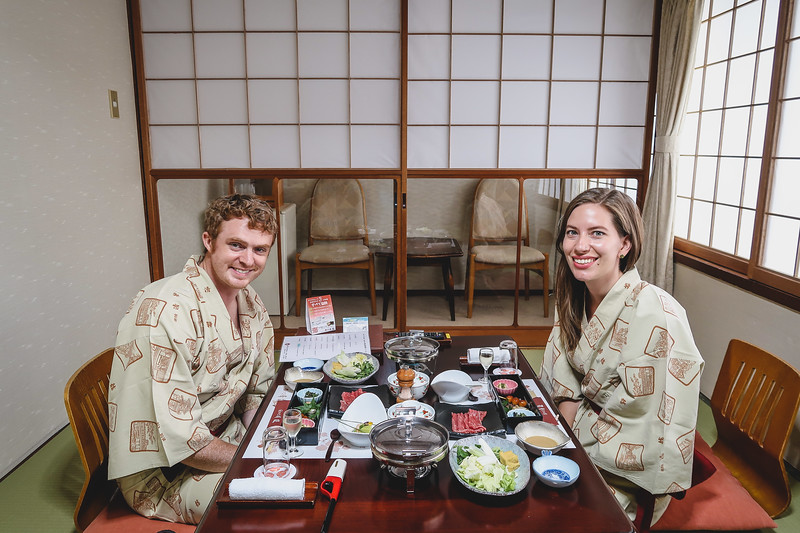
All The Best Things To Try Eating and Drinking in Takayama, Japan
Takayama Ramen
The fun thing about eating ramen in Japan is that every city has its own take on the dish, and of course, one of the foods to try in Takayama is its ramen!
Takayama noodles were high on our list, and it wasn’t long before we found a noodle shop that lured us in with its replica ramen bowls.
Seriously, you’ve got to love Japan’s fake food displays – they just make everything look so enticing!
We grabbed a table at Kajibashi, a cosy ramen restaurant with dark wood panels and a dimly lit interior.
I couldn’t help feeling like I was at a pub, except with bowls of ramen on the menu.
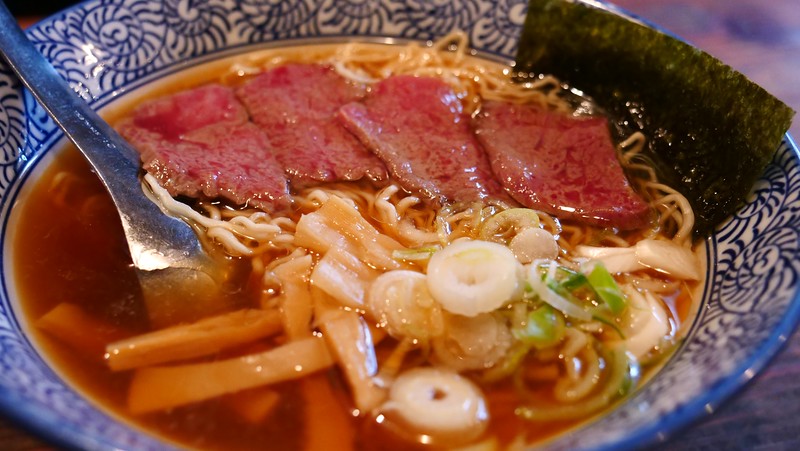
Sam and I decided to order two different bowls of ramen to do a little comparing.
I got the classic Takayama ramen which came in a dark miso broth with noodles, bamboo shoots, scallions, seaweed and a slice of pork.
Meanwhile, Sam got the Hida beef noodles featuring exactly the same ingredients, except the pork was swapped for four slices of Hida beef and a price tag to match.
We found the Takayama noodles to be thinner and curlier than previous ramen experiences.
The broth was enriched with soy sauce and miso, so it was quite a bit saltier than I’m used to, but still very tasty.
Also, note that we got the regular bowls but you can go even bigger if you’re feeling hungry!
Hida Beef
Another popular food to try in Takayama is Hida beef.
Hida beef is the name given to beef from black-haired Japanese cattle that have been raised in the Gifu Prefecture.
What sets this beef apart is the marbling (a mesh-like fat that runs through the meat), which makes it quite tender and gives it a distinct juiciness.
We tried Hida beef a few different ways during our visit to Takayama.
First, we tried Hida beef sushi, also known as Hida beef nigiri, where it is served on top of rice.
The meat was lightly torched and that melted a bit of the fatty marbling. It was served slightly pink (medium-rare) and just melted in our mouths.
The Hida beef nigiri is one of those must-try foods in Takayama and the best part is that you can get it in restaurants or as street food.
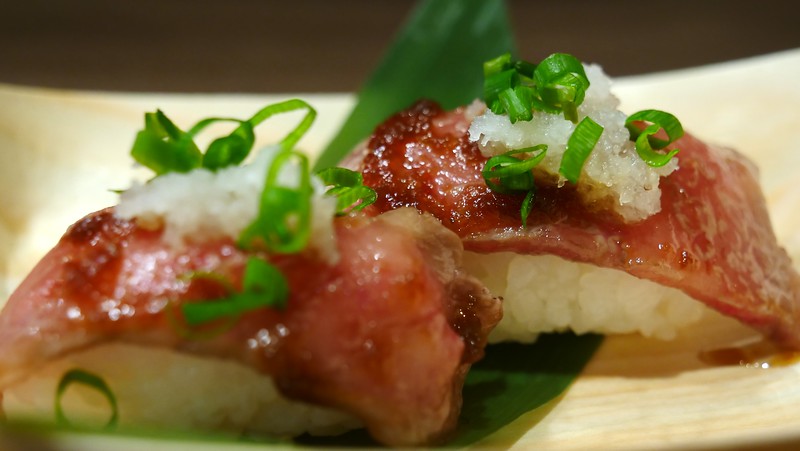
Because the ryokan where we spent the night specialized in Hida beef, we also got to try it at dinner time 3 different ways.
We had Hida beef steamed buns, Hida beef shabu shabu, and lastly, Hida beef steak. Each dish was so unique and showcased the versatility of the beef.
Most restaurants in Takayama feature Hida beef in some shape or form, so keep your eyes open if you want to try this local speciality.
Street food and snacks
Sam and I really enjoy visiting markets and trying the local street food wherever we travel, so in Takayama we did exactly that.
We visited the Miyagawa Morning Market, which is set on the east side of Miyagawa River and also spreads out to some of the side streets.
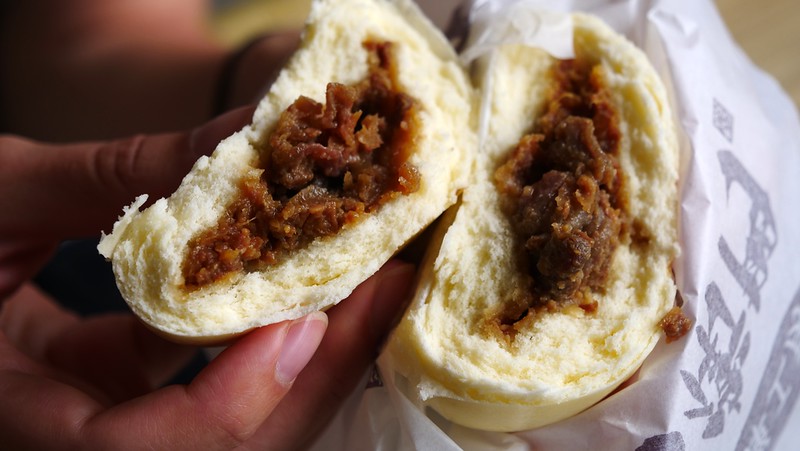
Here’s a list of some of the street food we tried along with prices:
- Chestnut Ice Cream: a wafer cookie shaped like a chestnut, but filled with vanilla ice cream. It would’ve been cool if it was actual chestnut ice cream – ¥250
- Hida Beef Bun: a plump steamed bun filled with sweet Hida beef and bamboo shoots – ¥430
- Hida Beef Croquette: a fried mash potato croquette with minced Hida beef – ¥190
- Hida Beef Skewer: grilled Hida beef on a skewer with a bit of ground pepper – ¥450
- Hida Beef Takoyaki: ball-shaped snack filled with pieces of beef instead of the classic octopus – ¥350
- Rice Crackers: crunchy crackers wrapped in dry seaweed with all sorts of seasonings like wasabi and spice – ¥120-150
- Soy Sauce Ice Cream: soft-serve vanilla ice cream with soy sauce, which was salty yet refreshing – ¥380
- Hida Beef Nigiri: lightly broiled Hida beef on top of rice, so think of it as beef sushi – ¥700
Tea and traditional Japanese sweets
So far we’ve talked about savoury foods to try in Takayama, but it’s time to move on to the desserts!
As you may have noticed in our videos, we had a lot of rain during our trip to Takayama, and since we couldn’t do much outdoors, one afternoon we decided to visit a traditional Japanese tea house.
We were the only guests at the time, so we grabbed the table on the tatami floors and got to perusing the menu.
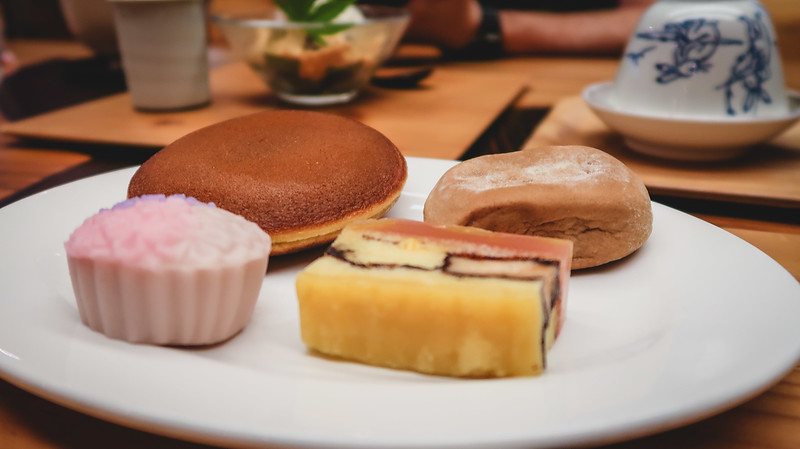
For dessert, we got the warabimochi which is a jelly-like mochi served with toasted soybean powder. The mochi was matcha flavoured and it came with red beans and a scoop of vanilla ice cream.
Aside from that, we also ordered the dessert platter, which came with four treats. There was a fluffy pancake sandwich stuffed with red azuki beans, a purple sweet potato dessert, a sponge cake with a delicious jelly, and a ginger almond cake.
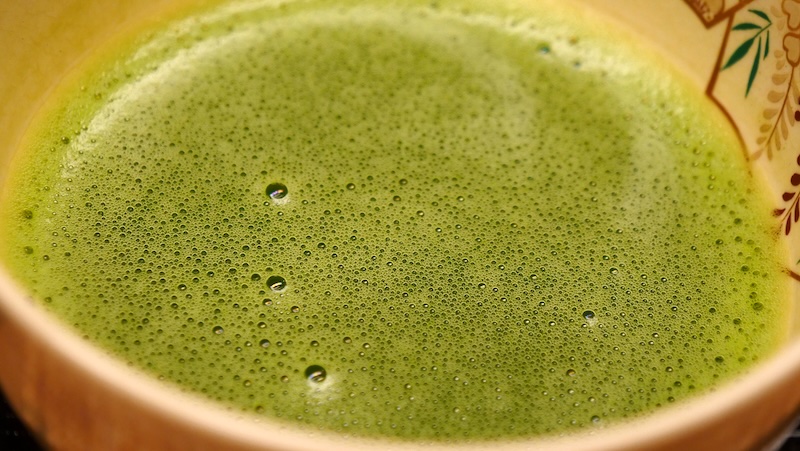
We paired all of this with a matcha tea and roasted tea. The matcha was a bit bitter for my taste, but the roasted tea was the perfect pairing for the desserts, in my opinion.
This was one of my favourite moments in Takayama and a really fun way to spend a rainy afternoon.
This particular tea house has changed hands since we last visited, so the tatami floors and low tables are gone, but they still serve tea and traditional Japanese desserts.
You can find it on GoogleMaps as 恵那川上屋 高山花筏店.
Mountain vegetables and Buddhist cuisine
When it comes to foods to try in Takayama, another unique experience is eating sansai ryori.
Sansai means “mountain vegetables” and the ingredients used in the preparation of these dishes are typically foraged not farmed.
These mountain vegetables are often used as ingredients in shojin ryori, or Buddhist vegetarian cuisine.
The restaurant we ate at was listed as “Local Cuisine Hisadaya” on GoogleMaps, but the sign read “Antique” once we reached the place.
We were a bit confused at first, but the photos matched the place even if the names didn’t!
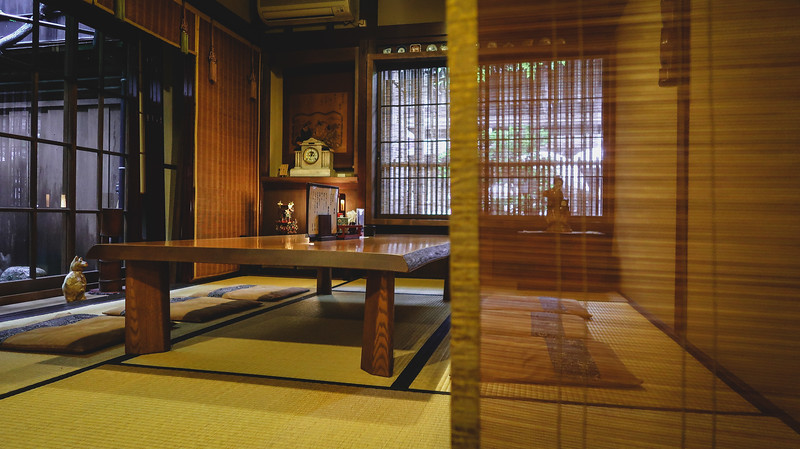
The interior of this restaurant was beautiful and everything you’d expect from Japan.
We dined in a traditional setting with low tables and cushions, soft music playing in the background, and an exquisite array of little dishes.
We ended up ordering two kinds of sansai ryori platters which featured compartmentalized dishes with various kinds of pickled and seasoned mountain vegetables.
The dishes featured wild mushrooms, tofu, pickles, radishes, water chestnuts, bamboo, roots and shoots.
Each meal also came with a bowl of rice and a cup of green tea.
The only difference between the platters that Sam and I ordered was that mine was entirely vegetarian and his came with fish and meat.
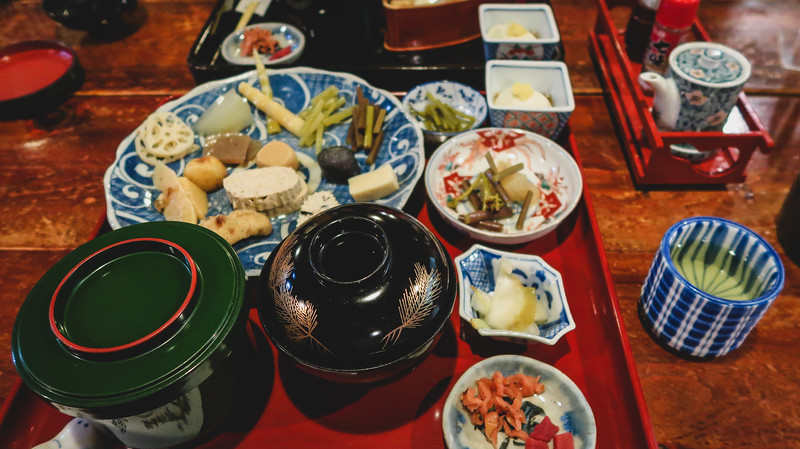
When we first decided to eat at this restaurant I wondered whether “mountain vegetables” would be a substantial enough meal or whether we’d leave hungry…well, we left beyond satisfied!
The dishes may appear small, but they all added up.
Multi-course kaiseki meal
Ryokans typically specialize in kaiseki cuisine, a traditional multi-course dinner with special attention to presentation and hospitality.
These meals were once reserved for the royal noble classes, but today it’s part of Japan’s haute cuisine and staying overnight in a ryokan is a great way to get this experience.
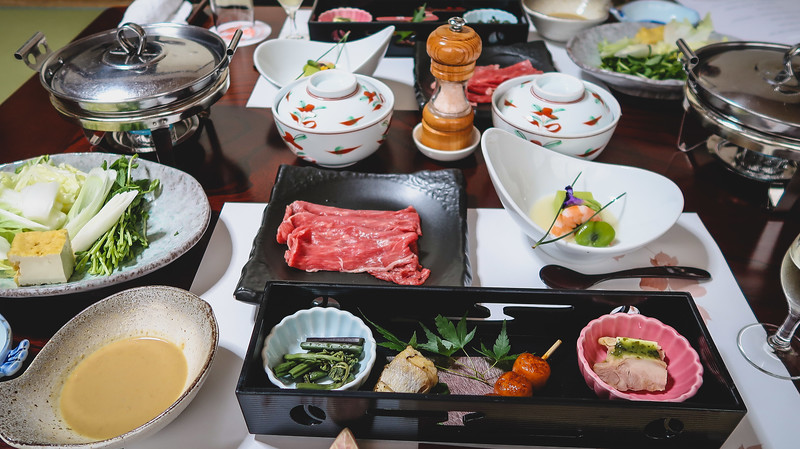
We started the meal with a sweet quince beverage, that was crisp and refreshing, and tasted somewhere between a wine and a liqueur.
We then experienced course after course of tiny dishes with impeccable presentation and attention to detail. Each dish was a work of art!
Some highlights included fatty roast pork with vegetables, bonito fish with ginger sauce and radish, and a pot of shabu-shabu with Hida beef.
We’ll take you through each and every course of the meal in the video below.
How to Plan, Order & Savour Your Way Around Takayama
If you’ve made it this far, you already know Takayama is a foodies paradise. By now you already know the what—Hida beef that dissolves on your tongue and kaiseki plates that look like edible ikebana—but let’s talk about the how. The section below distils everything Sam and I learned between bowls of noodles and drizzle-soaked umbrella runs, so you can spend less time staring at menus and more time tasting.
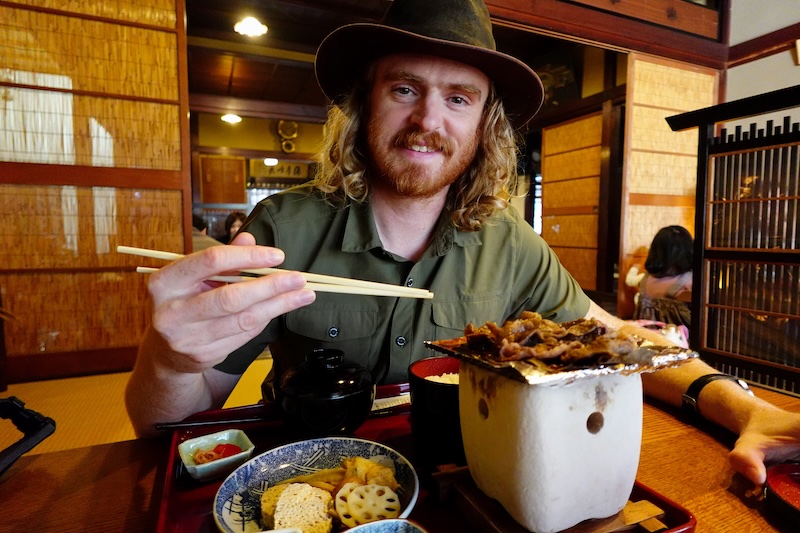
Mapping Your Meals: Timing Is Everything
| Meal | Best Time To Go | Why |
|---|---|---|
| Miyagawa Morning Market | 07:00–09:00 | Vendors fire up grills early; popular stalls sell out before tourists roll off the tour buses. |
| Lunch Ramen | 11:00 sharp | Most noodle shops seat fewer than 20; arrive when they unlock or expect to queue in the drizzle. |
| Mid-afternoon Tea | 14:30–16:00 | Perfect lull between lunch crush and dinner prep. Teahouses rarely rush you, so linger. |
| Sansai Dinner | 17:30–18:00 | Hisadaya/“Antique” can only seat a handful of parties per sitting. Early birds nab the tatami alcoves. |
| Kaiseki at Ryokan | Pre-booked | Confirm dietary needs 24 hrs ahead—chefs source ingredients that morning. |
Tip: Many independent restaurants close one day a week (often Wednesday or Thursday) plus irregular “snow days” in winter. A quick Google call-out confirms hours.
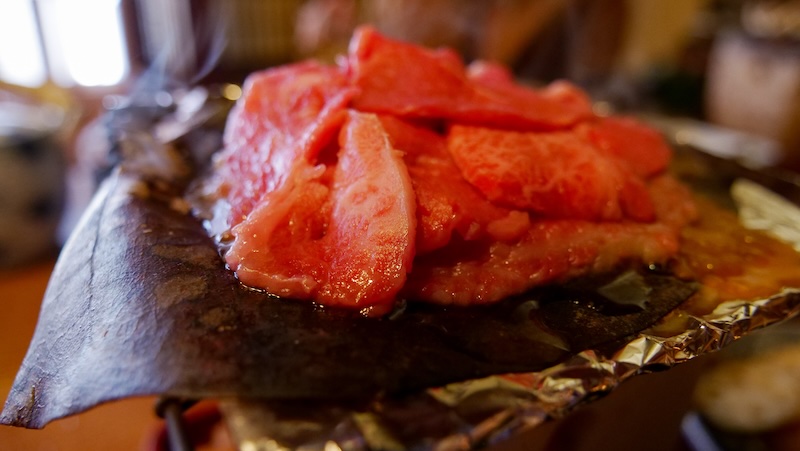
Decoding the Menu: Japanese Terms Worth Knowing
You’ll often see dishes listed in Japanese only, sometimes handwritten on wooden slats. Memorise (or screenshot) these keywords to order like a pro:
- 飛騨牛 (Hida-gyū) – Hida beef, the star of the show.
- 朴葉味噌 (Hōba-miso) – Local miso grilled on a magnolia leaf, sometimes topped with vegetables or beef slices.
- 高山ラーメン (Takayama rāmen) – House-style ramen, also called chūka-soba on older signs.
- 山菜 (Sansai) – Mountain greens; look for 天ぷら (tempura) or おひたし (ohitashi, blanched greens) variations.
- だんご (Dango) – Rice-flour dumplings on skewers. In Takayama they’re often basted with soy or miso, not the sweet soy you find elsewhere.
- 赤かぶ漬け (Akakabu-zuke) – Pickled red turnip, a staple banchan you’ll see at breakfast buffets.
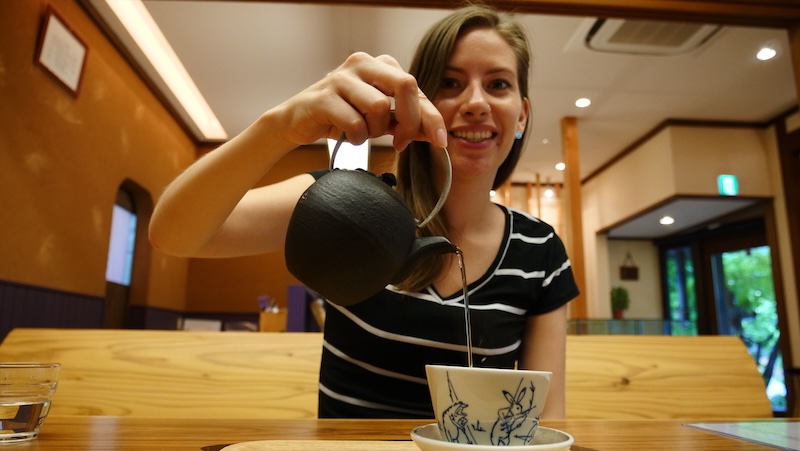
Navigating Seating Styles
- Counter Nooks: Solo travellers or couples should aim for the bar—front-row seats to watch noodles pulled, beef torched, or miso leafs sizzle.
- Sunken Kotatsu: Some restaurants offer heated tables recessed into the floor. Shoes off, legs dangle = toasty bliss in winter.
- Communal Benches at Markets: Feel free to share space; locals love to swap recommendations, and you’ll likely walk away with a new snack tip.
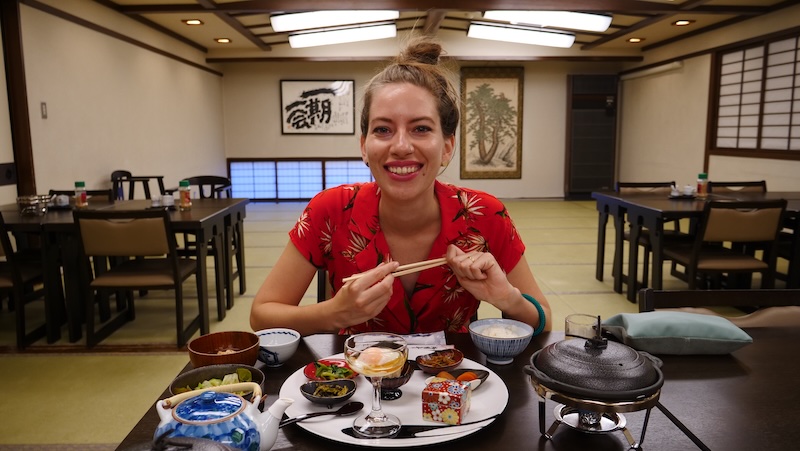
Crafting Your Personal Food Crawl
If you only have 24 hours in Takayama, here’s a “progressive dinner” that hits every major taste group without blowing the budget:
- 08:00 – Chestnut Ice-cream & Dango
Wander the Miyagawa Morning Market with a sweet–salty combo breakfast. - 10:30 – Hida Beef Croquette
Grab one on the way to Takayama Jinya; eat while queueing for the magistrate’s historic house. - 12:00 – Classic Takayama Ramen
Kajibashi closes once broth runs out—arrive before the sign flips to 売切れ (sold out). - 15:00 – Matcha & Warabimochi
Duck into a teahouse when the afternoon shower passes through. - 17:30 – Hōba-miso with Sake Flight
Many izakayas let you grill it yourself. Pair with local nihonshu made from pristine Hida spring water. - 19:30 – Hida Beef Nigiri Night-cap
Finish with two melt-in-your-mouth pieces from a stall near Nakabashi Bridge. Crisp night air, lanterns glowing—chef’s kiss.
Total damage: About ¥6,500 (≈US$45) and a very happy belly.

Pairing Drinks Like a Local
- Hida Sake – Look for breweries like Funasaka (船坂) or Hirase (平瀬). Their junmai ginjō pairs elegantly with delicate sansai plates.
- Doburoku – Unfiltered farm-style sake, slightly effervescent and cloudy. A warming choice for winter evenings.
- Local Craft Beer – Hida Takayama Beer taps pour a dark Lichtenstein-style lager that stands up to marbled beef.
- Hōjicha Latte – Roasted green-tea latte found in cafés along Sanmachi Suji; perfect with chestnut sweets.
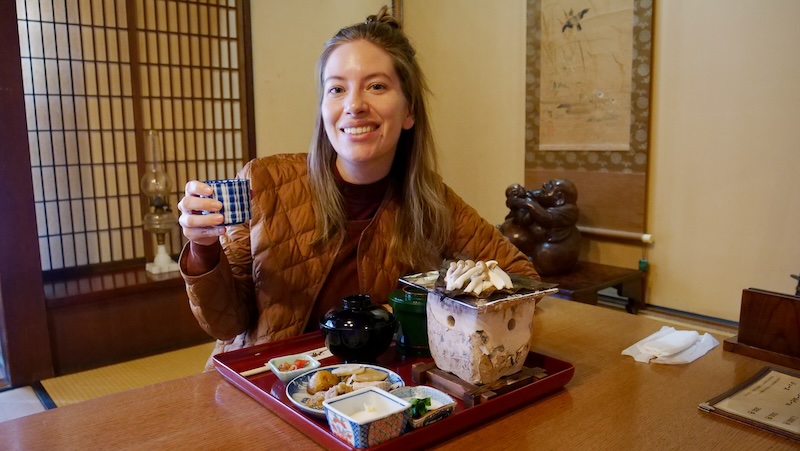
Budget vs. Blow-Out: Where to Splurge
| Experience | Cost (PP) | Worth It? | Why |
|---|---|---|---|
| Hida Beef Sushi Street Stall | ¥700–800 | ★★★☆☆ | Tasty teaser, but two bites vanish fast. |
| Hida Beef Steak at a Specialty Grill | ¥4,000–6,000 | ★★★★★ | Showcases marbling; cooks interactively on hot plate. |
| Kaiseki at Mid-range Ryokan | Included / ¥8,000 day-guest | ★★★★★ | Do it for the cultural deep-dive, not just the food. |
| All-You-Can-Eat Shabu Shabu | ¥3,500–4,500 | ★★☆☆☆ | Quantity over nuance; fine for big groups on tight budgets. |
| Tea Ceremony With Sweet Pairing | ¥1,500–2,000 | ★★★★☆ | Slow-travel moment and chance to ask about wagashi ingredients. |
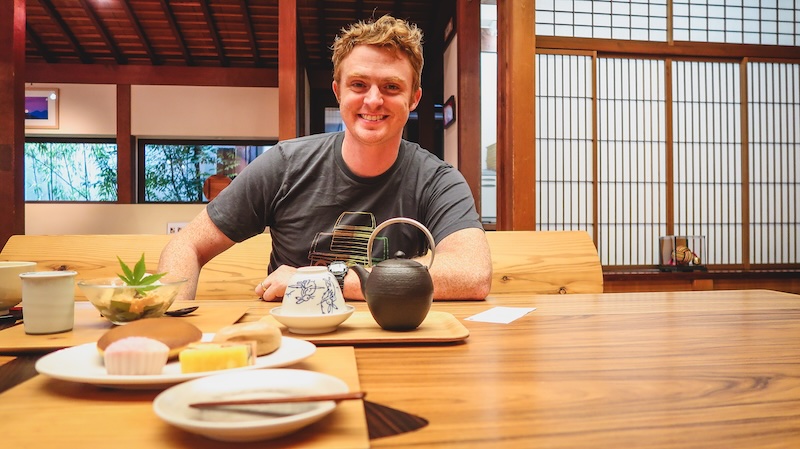
Seasonal Specialties You Might Miss (But Shouldn’t)
- Spring (Apr–May): Sansai tempura featuring fiddlehead ferns & butterbur buds.
- Summer (Jun–Aug): Ayu (sweetfish) grilled whole on skewers by river-side stalls.
- Autumn (Sep–Nov): Chestnut monaka wafers and fresh pressed apple cider from nearby Hida orchards.
- Winter (Dec–Mar): Mountain yam hot-pot (tororo nabe) and piping-hot amazake at shrine illuminations.
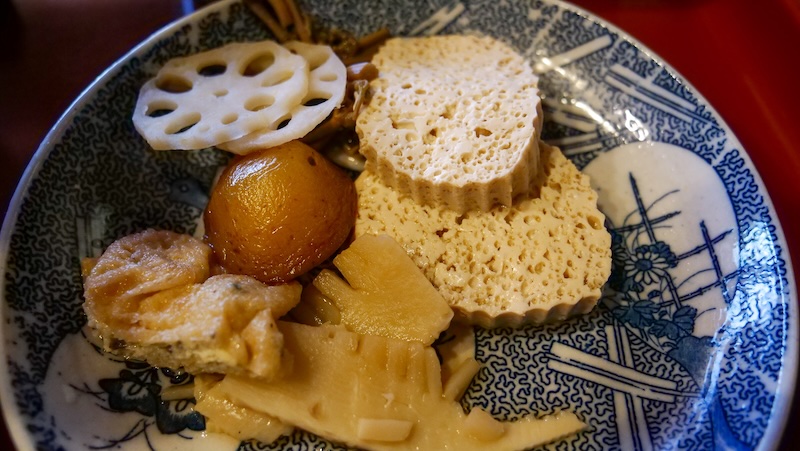
Dietary Notes & Veg-Friendly Hacks
While Takayama leans carnivorous, vegetarians/vegans aren’t out of luck:
- Shojin Ryori Restaurants – Ask your ryokan to reserve at least 24 hrs ahead; Buddhist kitchens often require prep time for dashi without fish flakes.
- Sansai Platters – Confirm with the chef: “Niku to sakana haitte imasuka?” (Does this include meat or fish?). Most items are plant-based, but some may include katsuobushi topping.
- Hōba-miso DIY – Order the veggie version; grill fresh mushrooms, negi onions and bell peppers in miso until bubbling.
- Convenience-store Onigiri – Look for the kanji 梅 (ume) for pickled plum or 昆布 (konbu) for kelp filling—safe meat-free snacks between meals.
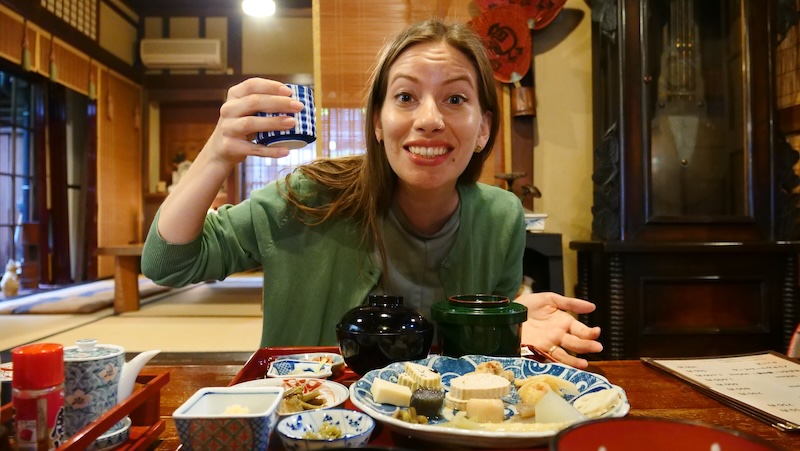
Food Souvenirs to Cram in Your Carry-On
- Keichan Spice Mix – A local chicken-marinade seasoning blend; sprinkle on stir-fries back home.
- Hida Beef Jerky – Vacuum-sealed, TSA-friendly, and dangerously addictive.
- Sarubobo Cookies – Shortbread shaped like the red faceless folk talisman you’ll see everywhere.
- Takayama Ramen Kits – Dried curly noodles + flavour packets for midnight nostalgia.
Tip: The shotengai (covered arcade) near Takayama Station has a takkyūbin desk where you can ship boxes home if bags are bursting.
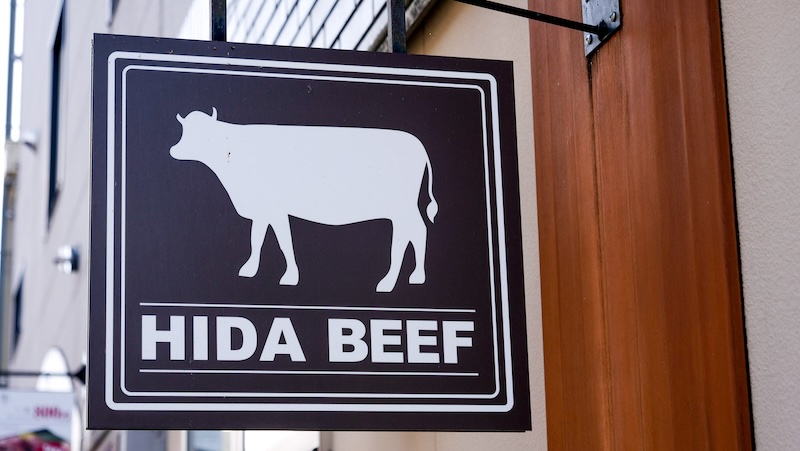
Takayama Food Guide FAQ: Hida Beef, Takayama Ramen, Tea Houses, Sansai & Kaiseki Essentials
What are the absolute must-try foods in Takayama?
Hida beef (in steak, nigiri, shabu shabu, buns, and skewers), Takayama ramen (aka chūka-soba), hōba-miso (miso grilled on a magnolia leaf), sansai (foraged mountain vegetables), and wagashi with matcha at traditional tea houses.
Where should I try Hida beef (and which cuts/styles are best)?
For pure marbling, choose a specialty grill for steak or hot plate searing; for a quick hit, grab Hida beef nigiri or croquettes at Miyagawa Morning Market. Don’t miss hōba-miso with thin beef slices—it’s a local classic.
What makes Takayama ramen different from other regions?
Broth leans shoyu/miso with a salty, savory punch; noodles are thinner and curlier. Toppings skew classic—bamboo shoots, scallions, nori—plus pork or an upgrade to Hida beef.
Is there good street food (and what does it cost)?
Yes—this is a fantastic snacking town. Expect roughly: buns ¥400–500, croquettes ¥150–250, skewers ¥400–500, takoyaki-style beef balls ¥300–400, soy-sauce soft-serve ¥350–400, Hida beef nigiri ¥600–800.
Where can I experience tea and traditional sweets on a rainy day?
Duck into a tatami-style tea house for matcha or hōjicha with wagashi like warabimochi, dorayaki, and seasonal cakes. It’s a cozy mid-afternoon reset when sightseeing pauses.
What is sansai/shōjin ryōri—and will it fill me up?
Sansai are foraged mountain vegetables often served shōjin-style (Buddhist vegetarian). Expect a lacquered tray of many small dishes—mushrooms, roots, shoots, tofu, pickles—plus rice and tea. Portions add up; you won’t leave hungry.
How do I try a proper kaiseki dinner?
Stay in a ryokan that specializes in kaiseki (multi-course haute cuisine). Notify dietary needs 24 hours in advance; chefs source ingredients the morning of your meal.
Can vegetarians/vegans eat well in Takayama?
Yes. Look for shōjin/sansai sets, veggie hōba-miso, tempura of seasonal greens, and onigiri with ume or konbu. Confirm “dashi without katsuobushi” if you’re strictly plant-based.
Any drink pairings I shouldn’t miss?
Local sake (junmai/ginjo) matches delicate sansai and kaiseki; cloudy doburoku warms winter nights; craft lagers pair with beef; hōjicha lattes play nicely with wagashi.
How do I plan meals to avoid queues?
Markets 07:00–09:00, ramen at 11:00 opening, tea 14:30–16:00, sansai/izakaya dinners 17:30–18:00. Many small shops close when they sell out—arrive early.
What food souvenirs are worth taking home?
Takayama ramen kits, Hida beef jerky (vacuum-sealed), sarubobo-shaped cookies, keichan spice blends, and seasonal chestnut sweets. Consider takkyūbin shipping if bags are bursting.
Any quick etiquette tips for eating around town?
Queue patiently, order promptly, and slurp ramen guilt-free. Shoes off for tatami rooms; say “itadakimasu” before eating and “gochisōsama deshita” after. Cash is king at stalls; keep coins handy.
Final Words: Why Takayama Should Be on Every Food Lover’s Map
And that’s a wrap for this food guide. I hope this blog post gave you a few ideas of foods to try in Takayama and hopefully, it has whetted your appetite for Japanese cuisine in general. Come hungry, come curious, and let Takayama surprise you. And if you discover a hidden gem, a new favorite dish, or a market stall worth raving about, drop a comment below—I’d love to keep this Takayama food guide growing for fellow travelers and adventurous eaters.
Happy eating, and itadakimasu!

Regional ramen with Hida beef, that is exotic!
The mountain vegetables set looks like it has well over 20 ingredients too.